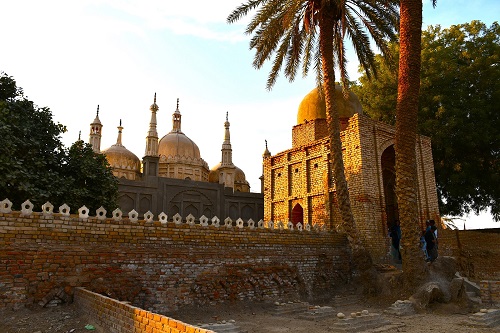
Khwaja Pir Ghulam Mohiuddin traveled to Shikarpur in Sindh twice: first in 1790 and later in 1806, and settled down permanently in Sindh.
Zulfiqar Ali Kalhoro
Shikarpur is the home of a number of shrines of Sufis and saints that belong to various Sufi orders. Three of the most popular shrines of Sarhandi saints are located in the Shikarpur district. The ancestor of the Sarhandis (Sirhindis) of Shikarpur was Khwaja Pir Ghulam Mohiuddin, who traced his ancestry back to Shaikh Ahmad Sirhindi (d. 1624). Khwaja Pir Ghulam Mohiuddin son of Khwaja Ghulam Muhammad Sadiq (1207 AH / 1793 AD) came from Peshawar and settled in Sindh in the first quarter of the 19th century.
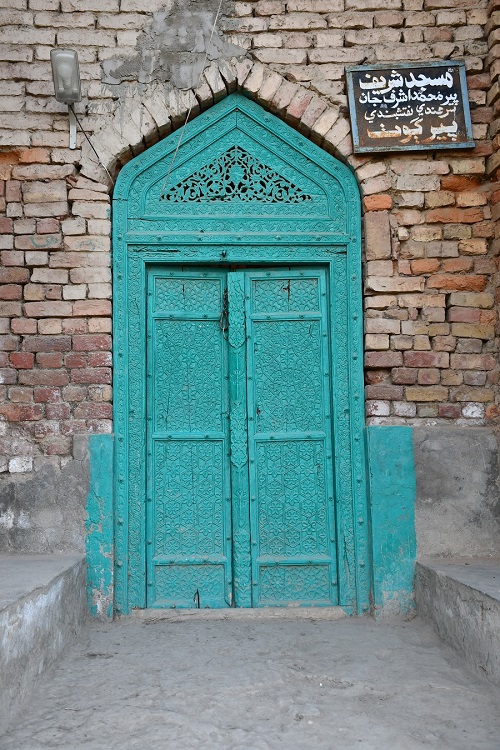
According to Sufia–e-Naqshband Vol.II by Dr. Sahibzada Abu al-Khair Muhammad Zubair (2007), Khwaja Pir Ghulam Mohiuddin was a descendant of Mujaddid Alf Sani (d. 1624). Khwaja Pir Ghulam Mohiuddin traveled to Shikarpur in Sindh twice: first in 1790 and later in 1806, and settled down permanently in Sindh. However, Munshi Atta Muhammad Shikarpuri (2005), the author of Tazan Mu’areken Ji Tarikh (Tarikh Taza Nawa’i Mua’rek) which is translated from Persian into Sindhi by Hakeem Niaz Humayouni, believes that he first travelled to Sindh from Peshawar in 1790 and later settled permanently in 1823 in Shikarpur, Sindh in wake of the Sikh occupation of Peshawar. He was held in veneration by both the Afghan governors of Shikarpur and Talpur Mirs of Sindh. Khwaja Pir Ghulam Mohiuddin set off for a pilgrimage from Shikarpur to Makkah. On way to Makkah, he halted at Hyderabad. His two sons Khawja Pir Nizamuddin and Khwaja Pir Fida Mohiuddin also accompanied his father. It is said that Nawab Moula Dad Afghan who was a governor of Shikarpur under Ameer Taimur bin Ahmed Shah Abdali also accompanied him.
Some historians believe that he first travelled to Sindh from Peshawar in 1790 and later settled permanently in 1823 in Shikarpur, Sindh in wake of the Sikh occupation of Peshawar.
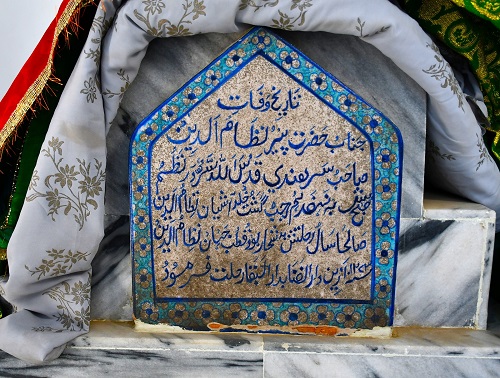
In Tazkira Mashahir Sindh Vol. 1 by Moulana Din Muhammad Wafai (1991), Nawab Moula Dad Afghan was said to be a follower of Khwaja Pir Ghulam Mohiuddin. People of Hyderabad had already heard a lot about Khwaja Pir Ghulam Mohiuddin’s piety and they warmly welcomed him when he reached there. Many people became his disciples in Hyderabad. Moulana Din Muhammad Wafai (1991) writes that Mir Karam Ali Khan Talpur, a Talpur ruler, had died a few weeks before he arrived in the city in 1828. Knowing his piety and piousness, he was approached by the Talpur nobles to pray for the deceased ruler Mir Karam Ali Khan Talpur (d. 1828). Khwaja Pir Ghulam Mohiuddin went to his grave and prayed for the deceased Talpur ruler for three days at his grave. The Talpurs of Hyderabad were impressed by his piety and bestowed on him and his sons about 25,000 acres of land in Sindh.
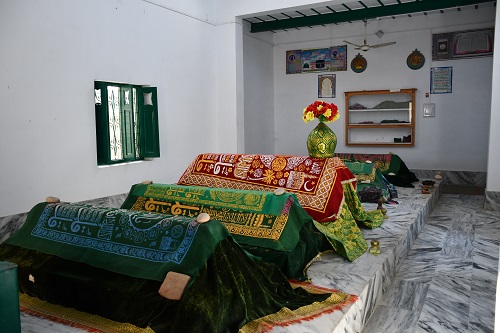
Khwaja Pir Ghulam Mohiuddin died in Hyderabad probably in 1828 or afterward. But as per the inscription on a wall of his tomb in Hyderabad’s Pathan colony, he died in 1828 in the same year when Mir Karam Ali Khan died. His date of death is not mentioned in any book or article that contains information on the Sarhandi family of Shikarpur. However, 1244 AH / 1828 AD is the date of death of Khwaja Pir Ghulam Mohiuddin, as per family tree/genealogy tree (shajra) of the Sarhandis of Shikarpur, which is in the custody of Abdul Sattar Sarhandi – who is the son of Pir Ghulam Mustafa and great-grandson of Pir Imamuddin, the elder son of Khwaja Pir Nizamuddin. This family tree was prepared with help of Fazal Ahmad Sarhandi (d. 1987) the son of Pir Shamsuddin by the Late Professor Aminullah Alavi, a famous scholar of Shikarpur.
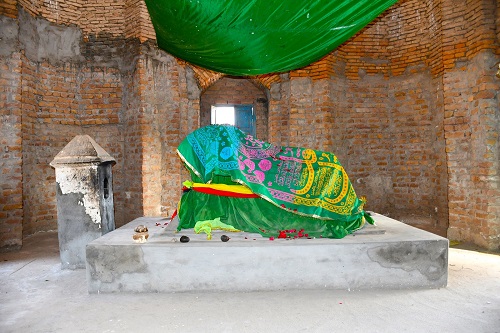
Khwaja Pir Ghulam Mohiuddin had two sons: Khwaja Pir Nizamuddin and Khwaja Pir Fida Mohiuddin. Both were born in Peshawar. Khwja Pir Nizamuddin was born in 1204/1789-90 in Peshawar. The elder son of Khwja Pir Ghulam Mohiuddin Khwaja Pir Nizamuddin lived in Shikarpur city while his younger son Khwaja Pir Fida Mohiuddin founded a village near Shikarpur which came to be called Pir Goth. It was also called Kot Habib Jagir. Pir Goth is located in Garhi Yashin taluka and situated about 6 km southwest of Shikarpur city.
Khwaja Pir Nizamuddin Sarhandi spent most of his time in his khanqah at Shikarpur. He was a Naqshbandi Sufi saint and preached Naqshbandi silsila in Shikarpur. Many people became his disciples. Hindus of Shikarpur also held him in high esteem and many were his followers. Moulana Din Muhammad Wafai (1991) writes in Tazkira Mashahir Sindh Vol. I that Seth Nevand Mal, a Hindu merchant of Shikarpur, who was also his disciple used to manage all the financial affairs of his guest house (Mehman Khana) and havelis/houses of Khwaja Pir Nizamuddin Sarhandi. He was also a poet and composed poetry in Persian. He wrote four books, two of the most prominent were Asrar Ramos Nasqhbandiyya and Mukhammas Karema.
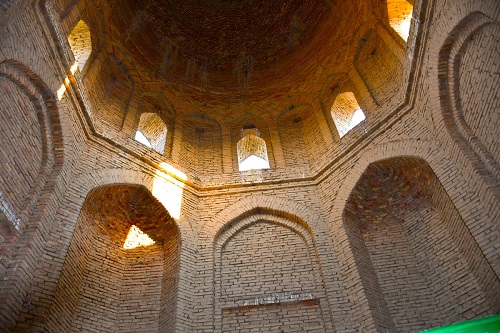
Both the Sarhandis and Alavis of Shikarpur played an important role in preaching the Naqshbandi silsila in Shikarpur. Khwaja Pir Nizamuddin died on 17 Rajab 1273 AH / 12 March 1857 AD as per inscriptions on the façade of his tomb and grave. The tomb of Khwaja Pir Nizamuddin Sarhandi Naqshbandi is located near Lakhidar in Shikarpur city. The tomb contains five graves including the grave of Khwaja Pir Nizamuddin Sarhandi. The four other graves belong to Pir Imamuddin Sarhandi (d. 1877) son of Khwaja Pir Nizamuddin, Pir Shamsuddin (d.1928), and Pir Noor Din (sons of Pir Imamuddin) and Pir Fazal Ahmed (d.1987) son of Pir Shamsuddin. There are a few other graves of descendants of Khwaja Pir Nizamuddin adjac Both Dr. Sahibzada Abu al-Khair Muhammad Zubair (2007) and Moulana Din Muhammad Wafai (1991) believe that Khwaja Pir Nizamuddin Sarhandi had nine sons. The elder son Pir Imamuddin became Gadi Nashin of the dargah of his father. Pir Imamuddin was also an eminent Naqshbandi saint of Shikarpur. He left for a pilgrimage to Makkah along with his sons Pir Shamsuddin and Pir Nuruddin and his followers. He stayed about six months in Makkah and Madinah. Moulana Din Muhammad Wafai (1991) believes that on the way back to Shikarpur he died in 1294 AH / 1877 AD near Lakki in Sehwan where he was buried. Later on, his eldest son, Pir Shamsuddin shifted his earthly remains from Lakki to Shikarpur and was buried next to his father. There are two prominent graveyards of the Sarhandi Pirs in Shikarpur city where descendants of Khwaja Pir Nizamuddin are buried: one is at his dargah (shrine) near Lakhidar and the other is located on Station Road. The third graveyard where the descendants of Khawja Pir Nizamuddin are buried is located in Baloch village near Habib Kot station in Lakhi Ghulam Shah taluka.
According to Pir Abdul Sattar Sarhandi, Pir Ghiasuddin (d.1883), the second son of Khwaja Pir Nizamuddin, is buried in Baloch village. Pir Khurshid Ahmad Sarhandi son of Pir Hassmuddin and grandson of Pir Ghiasuddin was also an eminent Naqshbandi saint the Sarhandi family of Khwaja Pir Nizamuddin. Pir Khurshid Ahmad died in 1952 and was buried in Baloch village. It is popular shrine in the area. There are other graves of Sarhandi Pirs in the necropolis of Pir Khurshid Ahmad Sarhandi in Baloch village.
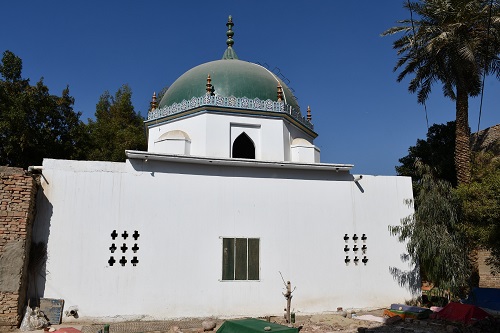
The younger brother of Khwaja Pir Nizamuddin Sarhandi, Khwaja Pir Fida Mohiuddin, used to take care of the agricultural land which was bestowed upon them by the Talpur rulers of Sindh. Khwaja Pir Fida Mohiuddin was also an eminent Naqshbandi saint from the Sarhandi family of Shikarpur. He lived in Pir Goth and died there in 1262 AH / 1846 AD. Khwaja Pir Fida Mohiuddin Sarhandi’s son Khwaja Pir Muhammad Ashraf Jan Sarhandi was also an eminent Naqshbandi saint in Shikarpur. He built a grand mosque and madrassah in Pir Goth. It is one of the most impressive and grand structures in the whole Shikarpur district. The main entrance of the mosque is crowned with a dome. The main portal of the mosque opens to the spacious courtyard. It is a three-domed structure with four decorative turrets rising from the parapet of the mosque. All the turrets are noted for stucco decoration – a type of decoration that is not seen in any other mosque in Garhi Yashin taluka in the Shikarpur district. The central dome of the mosque is crowned with an ornamental lantern, an architectural feature that can be seen in several mosques of Kalhora (1700-1783) and Talpur (1783-1843) periods and even in the British Raj (1843-1947).
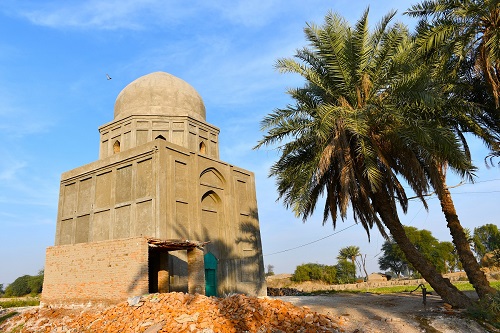
The front and interior of the mosque have recently been renovated. Adjacent to the mosque is the madrassah building which now lies in deplorable condition. There are ten graves of Sarhandi Pirs in the courtyard of the mosque. The grave of the builder of the mosque Pir Muhammad Ashraf Jan Sarhandi Naqshbandi (d. 1878) is also located in the courtyard of the mosque. To the northeast of the mosque is located the tomb of Khwaja Pir Fida Mohiuddin Sarhandi, the founder of the village. It is one of the most impressive structures in Garhi Yashin taluka. This tomb was either built by Khwaja Pir Fida Mohiuddin Sarhandi himself during his lifetime or by his son Pir Muhammad Ashraf Jan Sarhandi. The tomb is square from the exterior and octagonal from the interior. It contains a single grave that belongs to Khwaja Pir Fida Mohiuddin Sarhandi. The tomb has recently been renovated.
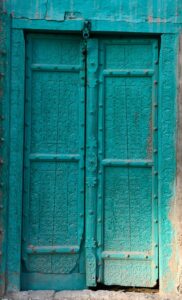
To the south of the mosque of Pir Muhammad Ashraf Jan Sarhandi is located another graveyard of Sarhandis where the five graves of Panj Pirs are located. According to Professor Abdul Hayee Moryani, the author of Shikarpur Jun Masjidon Ain Eidgah, those graves belong to Khwaja Fazal Mujaddid, Khwaja Amir Hyder, Khwaja Ghulam Hyder, Syed Saleh Shah, and an unidentified martyr from the Sarhandi family.
Both the mosque and the tomb of Khwaja Pir Mohiuddin are noted for ornate wooden carved doors.
The descendants of both Pir Khwaja Nizamuddin Sarhandi and Pir Khwaja Fida Mohiuddin played an important role in the socio-political history of Sindh in general and Shikarpur in particular in the 19th and 20th centuries.
Sara F. D. Ansari (1992) writes in Sufi Saints and State Power: The Pirs of Sind, 1843-1947, that Sarhandis (Sirhindis) were nominees of the Talpur Mirs during negotiations over the city of Shikarpur with the Afghan Dost Muhammad in 1834. Both brothers – Khwaja Pir Nizamuddin and Khwaja Pir Fida Mohiuddin were alive at that time, and they actually played a pivotal role in negotiations between Nawab Dost Muhammad and the Talpur Mirs. This shows how powerful and influential both Sarhandi brothers were in the socio-political milieu of Shikarpur.
It is said that both brothers also warmly welcomed Syed Ahmed Shaheed Barelvi (d.1831) when he passed by Garhi Yashin and Shikarpur.
_______________
 Dr. Zulfiqar Ali Kalhoro, an anthropologist, has authored 13 books: ‘Symbols in Stone: The Rock Art of Sindh’, ‘Perspectives on the art and architecture of Sindh’, ‘Memorial Stones: Tharparkar’ and ‘Archaeology, Religion and Art in Sindh’. He may be contacted at: zulfi04@hotmail.com
Dr. Zulfiqar Ali Kalhoro, an anthropologist, has authored 13 books: ‘Symbols in Stone: The Rock Art of Sindh’, ‘Perspectives on the art and architecture of Sindh’, ‘Memorial Stones: Tharparkar’ and ‘Archaeology, Religion and Art in Sindh’. He may be contacted at: zulfi04@hotmail.com
Courtesy: The Friday Times Naya Daur Lahore (Published on December 18, 2022)